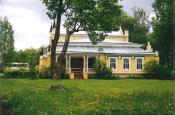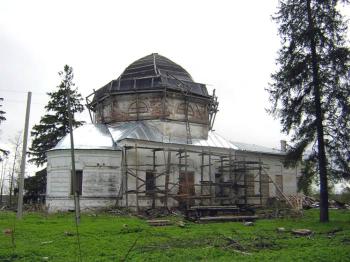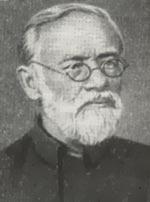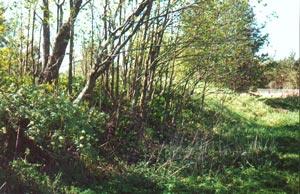Articles
/
Old Russian Kurgans (barrows)
Old Russian Kurgans (barrows)
Subject /
Relics
The Old Russian kurgans (barrows) are mounds over graves of the 10th-14th centuries. In old Russian towns barrow burials were stopped in the 11th century after adopting Christianity. The rural population continued to bury according to the Pagan ritual. The area of the Leningrad Oblast, where old Russian kurgans are located, include the Luga River upperstream region, the Izhora Hills and the north-eastern Chud Lake region. Barrow burials number from several to a thousand hemisphere-shaped mounds of 0.5-1.5 metres high. Barrows' foundations are edged with boulders or arounded with small ditches. During the 11th century they turned to bury unparched mortal remains (corpse-layout). The deceased person was oriented with the face turned to the next world side. Ingrian Finns put a corpse with the head at the northern or southern end of the grave, Slavs put a corpse with the head at the western end of the grave (with the face to the east). The funerary ritual was ended with the funeral service and funeral feast ("strava"). In the 11th - the first half 13th centuries the deceased persons were buried at the foundation of the mound. A pot with food was put at the foot. A sickle was put near women, men were buried with axes, scythes, arms. A knife in the case, a case with stone-fire were fastened to the belt. Slavs' and Ingrian Finns' burials are discerned with decorations of suits, details of funeral rituals. In the middle of the 13th century funeral ritual was undergone. Burials in pits without equipment and zhalnik-graves are spread. This radical turn was caused by the mass adaptation to Christianity of rural population. In far Chud pogosts barrows were made untill the 16th century. Mass excavations of barrows were fulfilled by L. K. Ivanovsky, N.K. Roerich, V.N. Glazov and others in late 19th - early 20th centuries. A.A. Spitsin systematized these materials. During 1927-1931 GAIMK (the State Archaelogy Institute of Material Culture History) workers were fulfilling the registration and calculation of survived sites. From the 1970s G.S. Lebedev, E.A. Pyabinin and others continurd the researches.
Authors
Plotkin, Konstantin Moiseyevich
Persons
Glazov, Vladimir Nilovich
Ivanovsky, Lev Konstantinovich
Lebedev, Gleb Sergeyevich
Roerich, Nikolay Konstantinovich
Ryabinin, Yevgeny Aleksandrovich
Spitsyn, Aleksandr Andreyevich
Geography
Topographical landmarks/Izhora Hills, the
Topographical landmarks/Prichudye North-eastern
Topographical landmarks/Verkhneye Poluzh'ye
Bibliography
Лапшин В.А. Археологическая карта Ленинградской области. Ч. 1-2. Л.; СПб. 1990-1995
Лебедев Г. С. Археологические памятники Ленинградской области. Л., 1977
Рябинин Е. А. Водская земля Великого Новгорода. СПб., 2001.
Спицын А.А. Гдовские курганы в раскопках В.Н. Глазова // Материалы по археологии России. Вып. 29. СПб., 1903
Спицын А.А. Курганы С.-Петербургской губернии в раскопках Л.К. Ивановского // Материалы по археологии России. Вып. 20. СПб., 1896
Mentioned in articles:
|
hidden
|
Burial grounds of the Izhora people.
Burial grounds of the Izhora people are concentrated in the Izhors tribe land in the Izhora and Neva rivers basin and on the south coast of the Gulf of Finland (see: Izhora). There are the data about 33 soil burial grounds. Excavations were made... more
|
|
|
|
hidden
|
Burial grounds of the Vod people.
Burial grounds of the Vod. Funeral sites of the North-western Vod ("Chud") were explored by E.A. Ryabinin in 1983-1988 in the former Vod parish of Kattila (Kotli Village of the Kingisepp district). The oldest type is presented by stone burial... more
|
|
|
|
hidden
|
Ethnic groups if the Leningrad Oblast
Ethnic communities of the Leningrad Oblast. The settled communities of people historically formed on the certain territory, having the common features of culture and self-consciousness expressed in the native name are called an ethnic community (or... more
|
|
|
|
hidden
|
Ivanovsky, Lev Konstantinovich (1845-1892), a scientist
Ivanovsky, Lev Konstantinovich (1845-1892), a doctor, archaeologist, anthropologist. He graduated the Medical and Surgical Academy in 1869 with the gold medal and he was suggested to work as an assistant lecturer at the descriptive anatomy... more
|
|
|
hidden
|
Izvara, a country estate
Izvara, a country estate (the village of Izvara, the Volosovo district). Firstly (since 1747) the grange was owned to Count K.E. Sivers. In 1872 St. Petersburg lawyer K.F. Roerich bought the estate with a stone manor-house built in the English... more
|
|
|
|
hidden
|
Ozeryovo, village
OZERYOVO, a village in Boksitogorsk District. Located on the left bank of the Chagoda River that floods at that point forming a kind of lake (origin of the village’s name.) Population: 22. The Zabelino-Krasnaya Rechka motor road extends close to O.,... more
|
|
|
|
hidden
|
Spitsin, Aleksandr Andreyevich (1858-1931), a scientist
Spitsin, Aleksandr Andreyevich (1858-1931), an archaeologist, Corresponding Member of the Academy of Scienses (1927). He graduated from the St. Petersburg University in 1882. From 1892 Spitsin worked at the Archaeology Committee (the Committee was... more
|
|
|
|
hidden
|
The Culture of long burial mounds (barrows)
The Culture of long burial mounds (long barrows). The new culture was extended on the vast territory included Pskov Lake, the Velikaya, Lovat, Msta, Mologa and Chagodoshch (partly) rivers in the middle of AD 1000. This culture is distinguished... more
|
|
|
|
hidden
|
Vodskaya Land
VODSKAYA LAND (Votskaya Land), historic, cultural, and administrative region of the middle-age Rus, located in the north-western part of Veliky Novgorod’s lands (western part of the current Leningrad Oblast.) First mentioned in the chronicle c.... more
|
|
|












